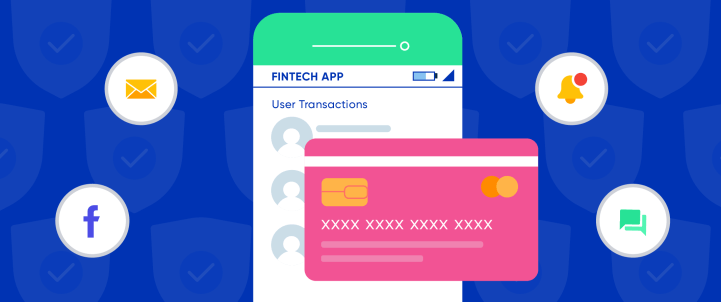With 2021 around the corner, how should Fintech marketers plan for the coming year? What strategies should be foremost on their minds?
We hosted a webinar series tackling the New Rules of Marketing Engagement, which brought together business leaders from various industries to discuss the challenges they face in marketing their brands and services to a global audience. And one session focused exclusively on Fintech, featuring:
- Adam Hadi, VP of Marketing, Current
- Annica Lin, Director of Performance Marketing & CRM, Thimble Insurance
- Hernando Rubio, CEO, MOVii
- Duena Blomstrom, CPO, People Not Tech & Author, Emotional Banking.
In the webinar, these speakers talked about how the new rules and methodologies are impacting not just marketing campaigns but also company-wide strategies in everything from content to communications to product. Summarized below is their combined wisdom.
Fintech’s Economic Realities
The industry experienced a great year in 2019. Registrations were up 71% vs 2018. And large Fintech brands had a 20% increase in monthly average users.
But 2020 has seen even more growth. A recent report* on global Fintech usage found a tremendous increase in average sessions across the board:
- Average sessions in investment apps grew 88%
- Average sessions in payment apps increased by 49%
- Average sessions in banking apps increased by 26%

COVID-19 basically accelerated changes and trends that were already happening in the finance world. Masses of people were already moving toward digital payments and being more open to Fintech services. The pandemic simply sealed the deal.
Which means the entire industry is now operating under new rules. But what are they?
Seize New Opportunities
Fintech, like every industry in the world, is facing a lot of new opportunities. It is one of the industries where the pandemic has actually forced people to change their habits and move toward online services.
In emerging markets, there are a lot of people who are informal workers with no employee subsidy — workers who are struggling to put food on the table. And governments help out by giving subsidies.
MOVii is a digital wallet based out of Colombia that offers financial services to people who are unbanked. The company saw an opportunity to provide services to those without bank accounts who needed a contactless way to access their money and pay their bills. Today, the app works to disburse subsidies provided by the Colombian government. Before the pandemic, the MOVii team saw users immediately withdraw the money and stop using the app, something that the team wanted to remedy.But these days, customers are actually using the money to pay their bills or purchase items, instead of withdrawing it, which is a success for the team.
“Banks have been offering services for hundreds of years, but since they have been using old technology and have a very expensive cost structure, their business model is defined based on charging fees. And only 20% of the audience can afford those fees. The other 80% are who the Fintech revolution is for.”
~ Hernando Rubio, CEO, MOVii
Similarly, Current is a New York-based mobile banking app that saw an opportunity to serve the people who had been overlooked by traditional banks — the hourly workers and freelancers, the people who don’t get regular bank deposits, or those who work in the gig economy.
Because these people live from paycheck to paycheck, they’re not always in the market for the products that traditional banks offer such as deposits, credit cards, loans, or mortgages. But they still need a bank to manage their money, which is where Current and other similar mobile banking services come in.
This also means Fintech is actually serving the segment of society that is hardest hit by the pandemic.
“Banking is obviously imperative to people’s financial outcomes. So making that affordable and non-predatory is really our mission.”
~ Adam Hadi, VP of Marketing, Current
Make Things Easy for Customers
Faced with changing customer needs, Fintech has to make accessing funds and financial products easier for their customers in order to thrive. The less friction, the better the chances at attracting and retaining customers.
A prime example: after noticing that a lot of people started lapsing on their insurance payments, Thimble, a New York-based online insurance provider, began to offer customers the chance to pause their insurance plans instead of outright canceling. Or if their plan had already lapsed, they gave customers the chance to buy the plan at the same rate they initially had.
They also offer helpful resources to their customers. Because a large majority of Thimble’s users are small business owners, they provide free guides tailored to specific locations with topics such as how to get funding from the local government.
“We offer them the most convenient way to pay for their insurance. We recently launched Apple Pay, Google Pay and all the major payment methods. That’s the best way we can make the payment process more streamlined.”
~ Annica Lin, Director of Performance Marketing & CRM, Thimble Insurance
Give Them Faster Access to Your Products
Traditional banks in the US make money off of deposits and loans, or upselling you to credit or mortgage products. But startup banks that eschew the traditional route have lower costs that allow them to offer full banking services without overdraft fees, minimum balance requirements, or direct deposit requirements.
Current’s business model is built around interchange fees — for example, the fees that a merchant pays to accept a credit card. This is money that is not coming out of customers’ pockets, but from the network. It allows them to give their customers access to their money faster than traditional banks. Users can get paid up to two days faster than traditional banks in most cases. In short, faster access to their money.
Similarly, Thimble prides itself on being able to give a customer access to an insurance plan within a 60-second signup process, making it convenient for new users to get what they need. In fact, they’ve seen a huge growth in blue collar workers who are using their app to get insurance coverage as soon as they get a job or a side hustle — something that a traditional insurance company would not be able to deliver that quickly.
Empathy is Still Key
And what about empathy? Common sense dictates that you market better when you see things from your customers’ perspective. Or in a marketer’s case, from the viewpoint of the user.
With Fintech marketing, you have to be incredibly sensitive to the reality of a customer’s financial situation and ask yourself: “What does this mean to the great majority of our users?”
“What you need to do now for that messaging to be authentic: it has to come from a place of ‘That’s what I’m feeling as well.’ It has to be a common experience between your brand and your customers.”
~ Duena Blomstrom, CPO of People Not Tech and author of Emotional Banking

The difficulty is we’ve all been taught to segment our audiences or to customize messaging to generations (millennials vs. baby boomers vs. Gen X). instead, find a common experience and build upon that.
What consumers want to hear is not that you’re there as a bank, or that you feel their pain. Instead it’s to hear from you that:
- You will be doing the things that they need from you right now.
- You have their back. And that you are feeling the same things they’re feeling. Although this is much more subtle and is something that customers sense more from what you don’t say than what you overtly say in your communications.
Retaining Users: Give Them Great UX & Make a Connection
What about retaining users? How can one build a great app and connect with users so they keep using your service?
Adam Hadi says that connecting is simply a matter of being relevant to the customer and not disrespecting their realities. He cites an example of a major bank poking fun at those working from home. But what if your users are essential workers, delivering the things that people need to survive? How tone deaf would that be?
He shares: “From a marketing perspective we’ve always taken the approach of being relevant. Traditional banks are not relevant to their lives, whether it’s the advertising, messaging, or their stories.”
Hernando Rubio shares: “If you can provide a service that is free of cost, and gives customers a great user experience, then you have the two factors necessary for exponential growth.”
But Duena Blomstrom says it best: “Beyond just making a useful product, to retain your customers you have to really reach them by going back to the moments when you’ve touched their heart. Go back to the emotional needs behind each transaction, and then imagine it in a world post-COVID where speed, agility, and the ability to stay human will matter. If you are able to bake those things into your product, then they will have a lot more staying power than just being useful.”
To watch the entire webinar on demand, check out the video below.
More Fintech Resources

A Marketer’s Guide to Personalizing User Experiences
Shivkumar M 
Head Product Launches, Adoption, & Evangelism.Expert in cross channel marketing strategies & platforms.
Free Customer Engagement Guides
Join our newsletter for actionable tips and proven strategies to grow your business and engage your customers.















































